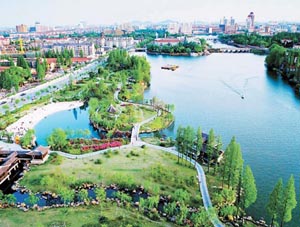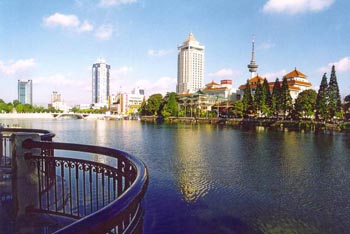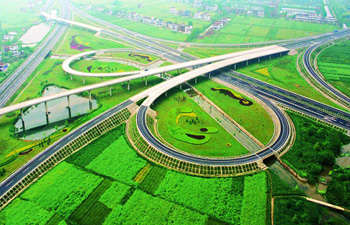| Home / English Column / Environment / Environment -- What's New | Tools: Save | Print | E-mail | Most Read |
| Port City Steps into the Future |
| Adjust font size: |
A port city in east China's Jiangsu Province, Nantong has made great strides in social and economic development during the 10th Five-Year Plan (2001-05) period.
"The 10th Five-Year Plan is the best ever period in the history of Nantong's development," said Ding Dawei, mayor of Nantong. According to the mayor, the city witnessed an annual growth of 13 percent in gross domestic product (GDP) and a yearly growth of 26 percent in fiscal revenues during this period. Last year alone, the city's economic volume reached 147.2 billion yuan (US$18.3 billion), ranking fourth among the top 13 cities in Jiangsu Province, and eighth among the 16 large and medium-sized cities in the Yangtze River Delta. Indices of GDP and per capita GDP both doubled compared with those of 2000. Also last year, newly approved contractual foreign investment exceeded US$5 billion, an increase of 34.2 percent year on year. Actually utilized foreign investment reached US$1.7 billion, ranking third in Jiangsu and among the top 15 nationwide. "Taking advantage of the great opportunities brought about by rapid economic development in recent years, Nantong is bound to make robust and continuous progress in the 11th Five-Year Outlines period from this year to 2010," Ding added. Harmonious development Meanwhile, the city government, with a scientific perspective of development, has made strenuous efforts to achieve harmonious and healthy social and economic growth. During the 2001-05 period, farmers' income increased as rural laborers were transferred to industries other than farming. The city's private sector continued to flourish, contributing to a lower unemployment rate. In addition, economic efficiency was improved as a result of economized utilization of resources and energy. Statistics from the local government show that Nantong's growth rate of energy consumption was 1.4 percentage points lower than its GDP growth, better than the national average. The coastal city has always paid much attention to environmental protection in the hope of creating an excellent living environment.
Pollution indices have continued to decrease because of sustained promotion of resources recycling and clean production. The quality of both air and drinking water sources meet national standards. Local authorities launched a series of greening projects to make the city an ideal place to work and live in. In the newly released 2005 Overall Competitiveness Ranking of China's Cities, Nantong topped the list in terms of government service. Both investors and residents spoke highly of the considerate, efficient and quality government service. "Safety and the living environment are among the city's major attractions for both local residents and investors," Ding said. Nantong ranked first in Jiangsu in terms of public security for two consecutive years and was thus named a national-level model city in that regard. Transportation Boasting 166 kilometers of watercourse along the Yangtze River and more than 20 kilometers of coastline, Nantong has a developed port industry. As one of China's 10 largest ports and the second largest along the Yangtze River, the Nantong Port has 38 docks with a capacity of 10,000 tons, 18 docks of 50,000 tons and two docks of between 70,000 and 100,000 tons.
To date, the port has had direct shipping routes connecting 312 ports in 75 countries and regions. The throughput of the Nantong Port amounted to 83.27 million tons last year, and capacity is expected to reach 100 million tons this year. With depth ranging from 16 to 25 meters, the Yangkou Port, an important port in the city, can accommodate vessels of 150,000 to 200,000 tons. At present, renowned companies from home and abroad are tapping the great potential of the Yangkou Port by investing around 30 billion yuan (US$3.73 billion) there. The city now has become one of the largest storage and logistic bases for ore, steel, chemicals, liquefied petroleum gas, grain and sugar in the lower reaches of the Yangtze River. It is also home to industries such as shipbuilding, textiles and garments, refined chemicals, electronics and energy. The coastal city has also set up a complete land and air transportation network. Nantong has a total of 217 kilometers of expressways, 1,568 kilometers of highways and two railways. Only 18 kilometers from the downtown area, Nantong Airport is able to serve D-level planes such as Boeing 737. In addition, the Sutong Bridge, which will link Nantong with Suzhou, another economic boomtown in Jiangsu, is under construction. "As we are seeking close cooperation with Shanghai, the Sutong Bridge - the world's longest suspension-cable bridge to be completed in 2008 - will also greatly shorten the distance between the two cities," said an official from the Nantong city government. At the same time, construction of two other bridges - one linking Shanghai, Chongming and Qidong and the other linking Shanghai, Chongming and Haimen - is also in full swing. Profile A quasi-peninsula sitting on the north side of the Yangtze River estuary, the city of Nantong has a pleasant temperate monsoon climate. Nantong, with an area of 8,001 square kilometers and a population of 7.738 million, has in its jurisdiction four county-level cites: Rugao, Tongzhou, Haimen and Qidong; two districts of Chongchuan and Gangzha; and the Nantong Economic and Technological Development Zone. As early as the 1890s, Nantong natives such as Zhang Jian, a noted entrepreneur and educator in China, began their efforts to modernize the city. Zhang shaped many firsts for his hometown, including the country's first normal school and folk museum. According to Wu Liangyong, a renowned expert in architecture and city planning, Nantong is known as "the first city of modern China" because it was the first to adopt modern ideas in urban planning. The rapid development of today's Nantong is also supported by a large number of dedicated intellectuals and talented professionals. For example, the Nantong University, with strong teaching and research capabilities, has cultivated many high-caliber talents for the city's rapid growth. Dubbed the "Home of Longevity," the coastal city has more than 500 residents older than 100 years, and has as many as 160,000 people over the age of 80. Besides, Nantong also enjoys the reputation of "cradle of world champions." In recent years, 46 world champions in 11 sporting events were from the city, four of them Olympic champions. The city also has many tourist attractions. The Haohe River in the downtown area, a well-preserved moat from ancient times, and Langshan Hill, famous for Buddhist culture, draws thousands of visitors from home and abroad every year. (China Daily March 9, 2006)
|
| Tools: Save | Print | E-mail | Most Read |
 |
| Related Stories |
|


